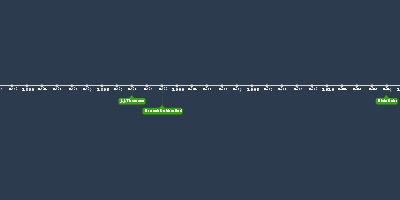dec 29, 1913 - Niels Bohr
Description:
Bohr proposed a new model for the hydrogen atom:1. The electron in a hydrogen atom travels around the nucleus in a circular orbit.
2. The energy of the electron in an orbit is proportional to its distance from the nucleus. The further the electron is from the nucleus, the more energy it has.
3. Only a limited number of orbits with certain energies are allowed. In other words, the orbits are quantized.
4. The only orbits that are allowed are those for which the angular momentum of the electron is an integral multiple of Planck's constant divided by 2.
5. Light is absorbed when an electron jumps to a higher energy orbit and emitted when an electron falls into a lower energy orbit.
6. The energy of the light emitted or absorbed is exactly equal to the difference between the energies of the orbits.
There are also some interesting points to highlight:
First, Bohr recognized that his first assumption violates the principles of classical mechanics. But he knew that it was impossible to explain the spectrum of the hydrogen atom within the limits of classical physics. He was therefore willing to assume that one or more of the principles from classical physics might not be valid on the atomic scale.
Second, he assumed there are only a limited number of orbits in which the electron can reside. He based this assumption on the fact that there are only a limited number of lines in the spectrum of the hydrogen atom and his belief that these lines were the result of light being emitted or absorbed as an electron moved from one orbit to another in the atom.
Finally, Bohr restricted the number of orbits on the hydrogen atom by limiting the allowed values of the angular momentum of the electron. Any object moving along a straight line has a momentum equal to the product of its mass (m) times the velocity (v) with which it moves. An object moving in a circular orbit has an angular momentum equal to its mass (m) times the velocity (v) times the radius of the orbit (r).
Added to timeline:
Date:
dec 29, 1913
Now
~ 111 years ago
